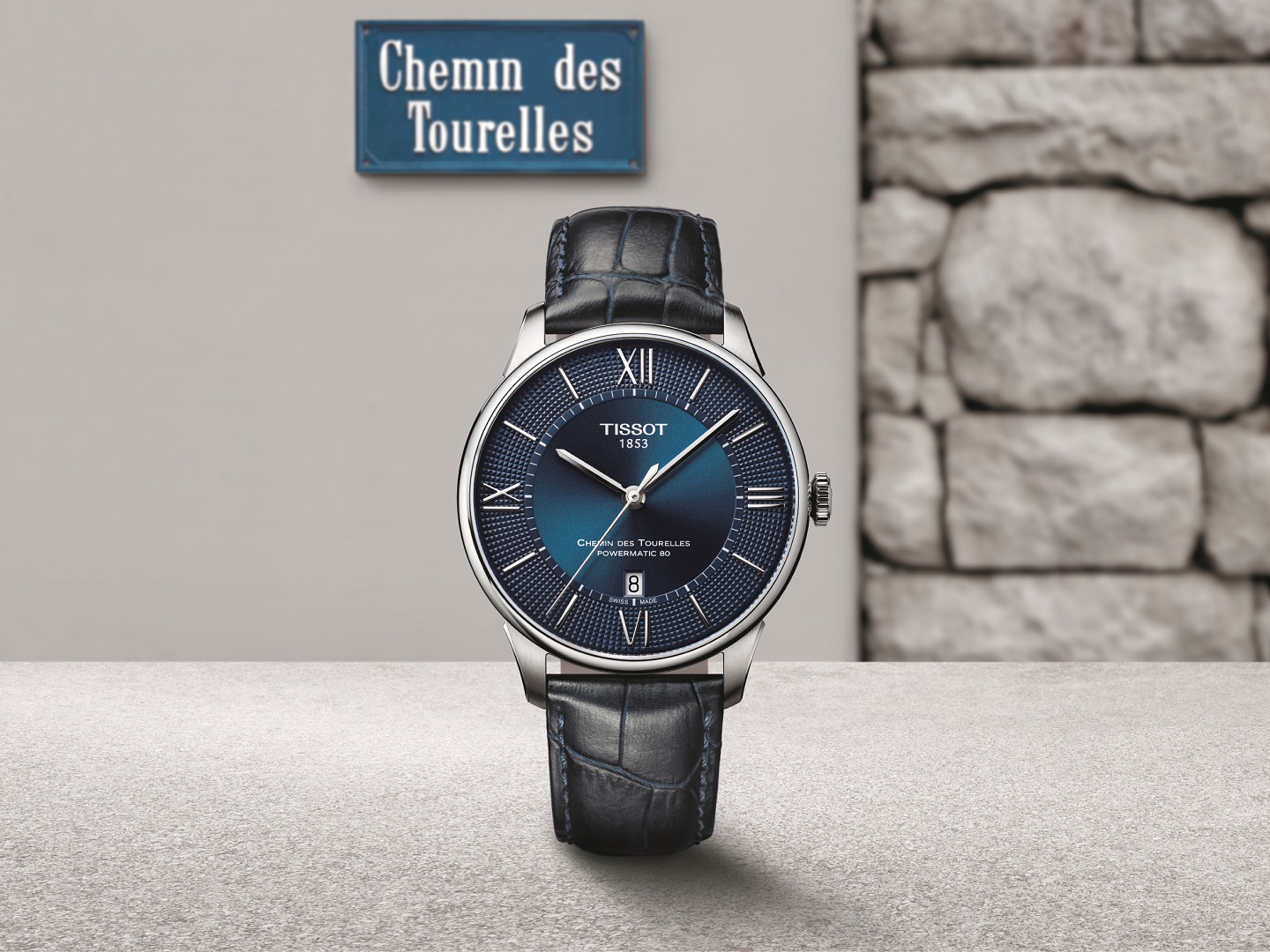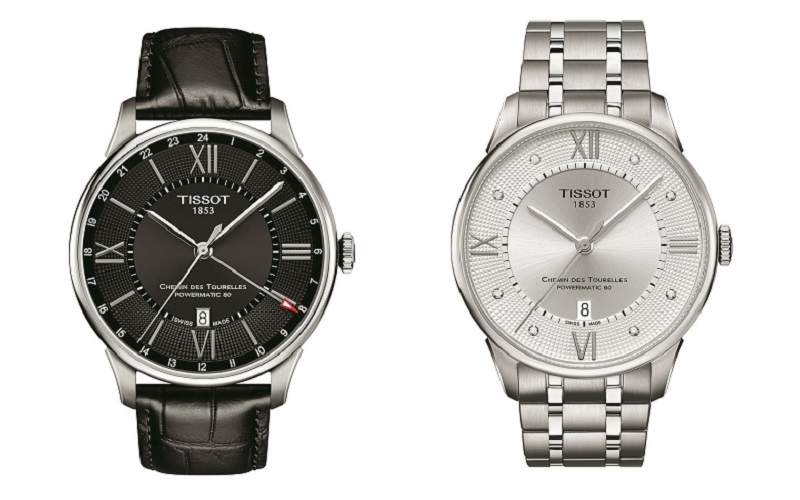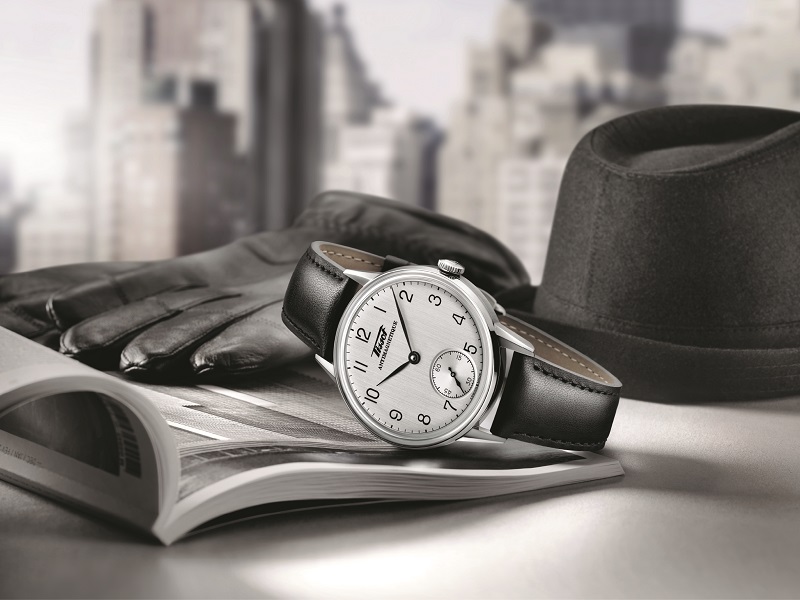
Chemin des Tourelles (Photo: Tissot)
As far as watchmaking history and provenance go, The Swatch Group-owned Tissot has some impressive street cred. Founded in 1853 by Charles-Félicien Tissot in the Swiss hamlet of Le Locle, this brand introduced the first mass-produced pocket watch as well as the first pocket watch with two time zones, and it is widely credited for the first anti-magnetic watch many years later, in the 1930s. While Charles-Félicien remained in Europe, his son Charles-Emile left for greener — not to mention richer — pastures in 1858, and succeeded in selling their savonnette pocket watches across the Russian Empire.
Over the years, Tissot has been responsible for a number of interesting innovations in watchmaking: It was the first to make watches using synthetic materials (the unconventionally shaped Idea, released in 1971 and again in 2001), stone (the Alpine granite Rock Watch in 1985), mother-of-pearl (the Pearl watch in 1987), and wood (the Wood watch in 1988).
At this year’s Baselworld watch and jewellery show, Tissot paid homage to Charles-Félicien’s factory in Le Locle with a traditionally-styled collection named after the street it was on — Chemin des Tourelles, where a Tissot boutique is located even to this day. The watches in the collection complement the company’s many years of expertise with a contemporary design anchored by an elegant case that comes in a variety of finishes, including polished and brushed, perfectly demonstrating the technical know-how Tissot puts into every timepiece it produces.
As a means to share this collection with as many fans of the brand as possible, Tissot has unveiled a number of new models with subtle differences — the idea is that even within a single collection, there is something for everyone. However, there are a few unifying factors — these are high-quality stainless steel watches powered by the same Powermatic 80 mechanical calibre that brings to life the time and date functions.
The watches for men are a generous 42mm — although many women don’t baulk at these sizes anymore — while smaller, more feminine wrists are served by a 32mm case. The dials come in a variety of styles and colours, depending on whether you prefer a completely uncluttered look and feel, or are the sort who likes a bit more going on in your watches. For example, some dials are completely uniform while some include a minute track or a ring-shaped Clous de Paris hobnail pattern within.

A silvered dial is timeless and classic, but the black, copper and blue dials are decidedly standout features. Slender hands glide over Roman or Arabic numerals interspersed with hour markers to define the passing of time and on one of the ladies’ versions, rubies replace hour markers to luxurious effect. The watches are completed with either metal link bracelets that hug the wrist ever so slightly or robust leather straps meticulously stained to perfectly match the various dial colours.
Mechanical mastery in the service of history and heritage — indeed, any of the timepieces in this collection is the one to covet from Tissot this year if a watchmaker’s provenance has always inspired you most.
Classicism and chronometry
Tissot has years of experience in producing high-precision and ultra-reliable mechanical watches, which has earned it many accolades in international chronometry competitions. One of its most outstanding achievements remains the Powermatic 80 movement, which is built with silicon balance springs for additional resistance, consistency and longevity — ideal characteristics in any timepiece. First launched in 2013, the movement gets its name from its 80-hour power reserve. It also boasts a second feature that is particularly fascinating — the calibre’s high-tech escapement has no regulator; the rate is set at the factory with a laser, making the manual rate adjustments normally required by a mechanical watch unnecessary.

Tissot has refreshed the Ballade collection for 2018 — it was first unveiled last year — fitting it with the Powermatic 80 movement. Design signatures of the Ballade include a Clous de Paris hobnail pattern on the bezel, a clean and unfettered dial, applied hour markers except for 6 o’clock and 12 o’clock, a minute track and a date window at 3 o’clock. Previous editions of this handsome stainless steel watch have included black dials and leather straps, while metal bracelets come with an option of yellow-gold PVD coating for a subtle colour addition.
This year, the Ballade has been released in a stunning bi-colour range that makes it both work- and weekend-ready. The 316L stainless steel linked bracelet with its beautifully polished links boasts pink-gold accents thanks to PVD coatings, while the pieces for women feature mother-of-pearl inlays in the centre of the dial. Case sizes for men are a generous 41mm and 39mm, while the women’s versions are 32mm and 30.6mm.
A worthy tribute
The elegant Tissot Heritage 2018 looks back to a wristwatch that was part of the brand’s collection in 1943. Originally a men’s watch for the city, it was a dapper and resilient choice thanks to its case made from nickel-chromium alloy with a small second hand, and 27mm calibre, which was a Tissot exclusivity. This watch was part of the iconic Tissot Antimagnétique collection, launched in the 1930s, comprising the first non-magnetic wristwatches in the world.

Today’s contemporary models pay tribute to the past with their design. The Tissot Heritage 2018 adheres to the same principles as the original, but uses modern production technology for the highest possible quality. A domed dial atop a silver dial vertically brushed with the Tissot logo of that time reflects the past, while the sequence of the oversized Arabic numerals is broken at 6 o’clock by a seconds window. Leaf-shaped hands complement a black vegetable leather strap with a folding clasp that make a stylish statement. Through the sapphire crystal caseback, the wearer can enjoy the steady ticking of a hand-wound mechanical movement, completed with blued screws and the Côtes de Genève and Heritage logos.


